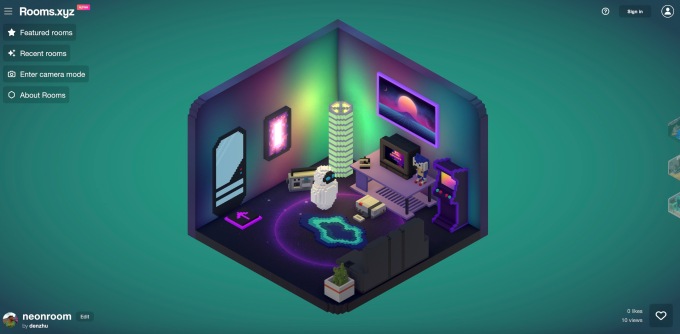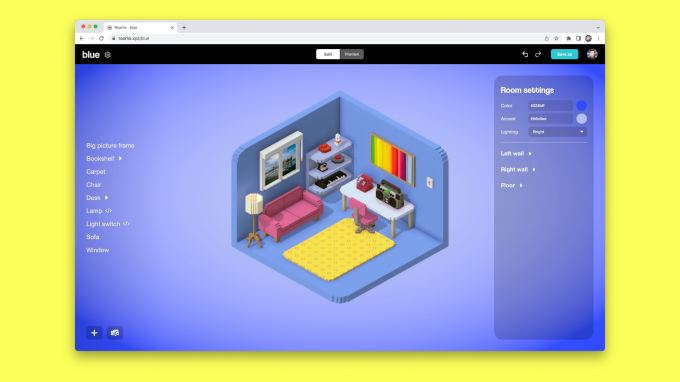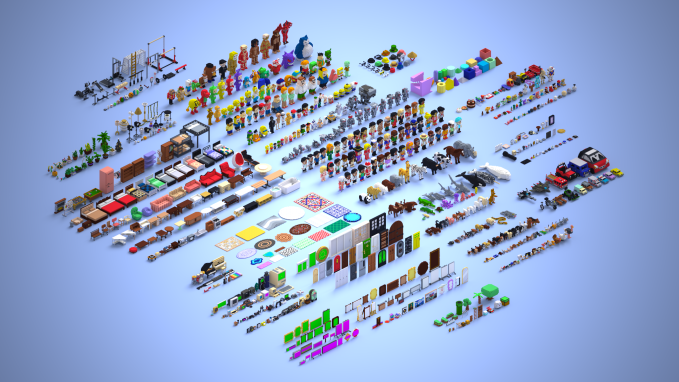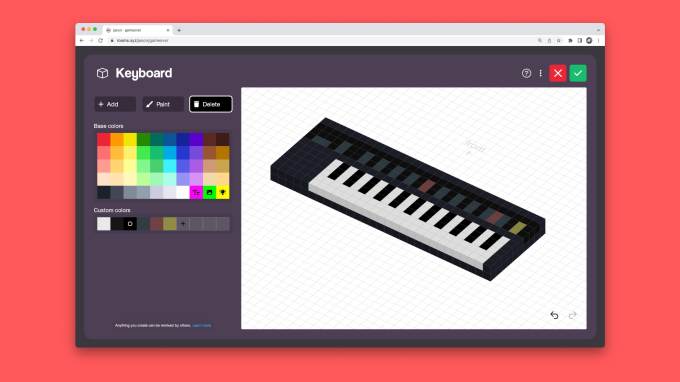A team of ex-Googlers is today launching a new digital creativity platform, Rooms.xyz, in beta testing. Backed by $10 million in seed funding led by a16z, the startup offers a browser-based tool for designing 3D spaces — or “rooms” — using drag-and-drop, editable objects or code, allowing users to express themselves through through creative play as they design rooms, basic games or other interactive activities in these small online spaces.
The idea is something between a simple creation tool like Minecraft and a more advanced world building platform like Roblox. Or, as the company describes it, it’s like the “digital equivalent of LEGO.”

Image Credits: Rooms.xyz
The idea for Rooms came about through a combination of factors, explains the co-founder Jason Toff – namely that making 3D models was way too difficult these days.
Prior to Rooms, Toff spent ten years at Google, off and on, in product marketing and product management, including YouTube, Area 120, and VR/AR. Prior to that, he worked at Vine for a few years as a Product Manager, also after the takeover by Twitter. And most recently, Toff worked at Meta, where he focused on new product experiments such as zine maker E.gg and music app Collab, among others.
After leaving his last position, Toff decided to take some time off, which he decided to fill by trying to learn how to make 3D models – something he always thought sounded fun. However, it turned out that the process was actually quite complicated and involved the use of complex software. Around the same time, Toff’s six-year-old son had just started playing Minecraft, where designing with 3D models was easy, but it had to be done block by block.
This led to the idea of something of a middle ground for 3D design, where the process would be almost as simple as in Minecraft, but the build unit wasn’t a single block. Instead, in Rooms, you can find, edit, and add a fully formed object to your space, such as a door, a sofa, a table, a bed, a car, decor, a pet, or anything else you can imagine.
The interface allows you to change an object’s characteristics and functionality, such as its color, size, position, or style, or what happens when you click on it.

The project also draws inspiration from other projects Toff worked on at Google’s AR/VR division, such as the VR and AR app building service Poly (which became another Google causal in 2020) and the VR 3D modeling tool. , blocks. Co-founder of Rooms Bruno Oliveira also worked on these projects at Google, which is how the two first met. Meanwhile third co-founder and iOS engineer Nick Krugecomes from Smule (where he was Director of Product Design) and Ubernext to Google, where he worked on YouTube mobile and YouTube Music.
“Basically, I wanted the company to make the digital equivalent of LEGO,” explains Toff. “The thinking was that LEGO is one of the few things that kids love, adults love, and adults want their kids to play with,” he says. But LEGO has limitations due to its physical, printed plastic nature. It can be expensive and you can lose parts, for example, Toff noted.
Like a box of LEGOS, Rooms is meant for open-ended play, where people use the objects to express themselves in some way – whether that’s building a small version of a real room, a dream room, or by creating some kind of interactive space. space, such as a simple game or a musical instrument that you can click to play, or anything else.
The startup has seeded its community with 1,000 Voxel 3D objects it has commissioned from creators, which can be added and modified in your own space. Each room is also public by default and can be “remixed”, that is, used as a template or starting point for designing your own room.

Image Credits: Rooms.xyz
There’s also an educational aspect to the software, as you don’t just have to interact with the objects through the user interface – you can also click to reveal the code. Rooms uses Lua, the same language used for coding in Roblox. That could help introduce younger users to coding concepts before moving on to Roblox’s more advanced editing tools.
While the rooms themselves are interactive and connectable, not much can be done with them once the design is complete, other than sharing their URL with others to show off. A “camera mode” allows you to take a photo or a smooth dolly shot, but the end result cannot be published to social networks with one click. Nor can users create avatars that can move or interact with others, or chat.
“That was an intentional decision – in part to keep this as safe as possible,” explains Toff. “Because once you introduce chat… people can do terrible things,” he says. Plus, he adds, there’s already too much focus on virtual personas and costumed avatars and the team wanted to pursue something else.
“For all I know, it could be a big mistake that we don’t have all of that — and it might make sense to introduce some sort of social experience later on,” admits Toff. “But for now it’s all just a website or a game you play. It’s all individual.”

Image Credits: Rooms.xyz
Ultimately, Rooms could make money selling objects for purchase, subscriptions or licenses for its software for education, but that’s all yet to be determined at this point. With the startup opening up to beta testing, the goal is to see how early adopters use the product and what they end up building or requesting, says Toff.
However, one area they are exploring is the use of ChatGPT. At the moment they have made an object of a fortune teller (Zoltar!) to which you can ask questions that are then answered by the OpenAI chatbot, speaking as Zoltar would. Users can copy that code and use it on their own AI objects by editing the prompt in the code to change the way their object responds.
An AI tool is also under development that will allow users to instruct the software to write code for the object they want and how it should behave.
For example, you could tell it to spin your object when clicked, and the AI would create the code you need. However, this functionality is not yet public.
the startup – Things Inc. — was founded in 2021 and raised $8 million in funding from Andreessen Horowitz (a16z) and $2 million from several angel investors, including Adobe Chief Product Office Scott Belsky and Instagram co-founder Mike Krieger. After burning money too quickly in the beginning, the team whittled down their 10-person squad to just the three founders to keep enough runway. Now Rooms.xyz has about four years, says Toff.
That could give the company, which was built through Unity, more time to launch on other platforms. An iOS app is currently in development that could serve as a companion for exploring the rooms built by others. But the team also plans to expand these creations to Apple’s and Meta’s AR/VR platforms in the future.
“We were like ‘let’s release this beta now’ because once Apple comes out with its [AR/VR device], we’ll see what it does and then we can figure out how to integrate it,” says Toff. “All of this is built to be very easy to put on a headset,” he adds.
Rooms.xyz is open for beta testing and free to use.
Janice has been with businesskinda for 5 years, writing copy for client websites, blog posts, EDMs and other mediums to engage readers and encourage action. By collaborating with clients, our SEO manager and the wider businesskinda team, Janice seeks to understand an audience before creating memorable, persuasive copy.

